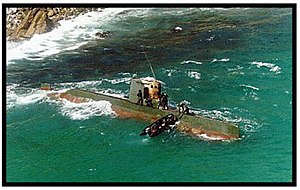1996 Gangneung submarine infiltration incident
| Infiltration of Gangneung | |||||||
|---|---|---|---|---|---|---|---|
 The Sang-O-class submarine stranded on the South Korean coast |
|||||||
|
|||||||
| Belligerents | |||||||
|
|
|
||||||
| Strength | |||||||
| 43,000 personnel | 1 Sang-O-class submarine 26 personnel |
||||||
| Casualties and losses | |||||||
|
12 killed
|
24 killed
1 missing 1 submarine captured |
||||||
| 4 South Korean civilians killed | |||||||
12 killed
24 killed
The 1996 Gangneung submarine infiltration incident occurred on September 18, 1996, near the South Korean town of Gangneung. The incident was one of the more serious instances of North Korean espionage involving naval forces.
On September 15, a North Korean Sang-O-class submarine landed a three-person special operations reconnaissance team on the east coast of South Korea near Jeongdongjin, 20 kilometres south-east of Gangneung, Gangwon-do. Their mission was to spy on the naval installations in the area and then return. The submarine made a failed attempt to collect the team on the 17th, and returned the following day. The submarine, however, ran aground in the attempt, and all efforts to try to make her free were in vain.
The crew then decided to destroy the sensitive equipment in the submarine and try to make it to the DMZ. The crew split up in several groups but one was soon spotted by a civilian who became suspicious and alerted the authorities, who quickly mobilized.
A 49-day-long manhunt ensued, from 18 September through 5 November, resulting in the capture or elimination of all the crew and members of the reconnaissance team, except one, who is believed to have made it back to North Korea. Four civilians and 12 ROK soldiers (eight by firefight and four accidental) died; 27 soldiers were wounded.
Of the 25 North Korean infiltrators, one was captured, 11 were killed by the other members for failure in responsibility of running aground of the submarine, and 13 were killed in firefights with the ROK Army. Some analysts suspected that the motivation behind the assassination of Choe Deok-geun, South Korean consul for the Russian Far East, was retaliation for these killings.
The submarine was salvaged and towed to a naval base for investigation. One captured crewmember, the submarine's helmsman, Lee Kwang Soo, gave in after much interrogation and revealed much of the plans. He later became an instructor in the South Korean navy.
...
Wikipedia
